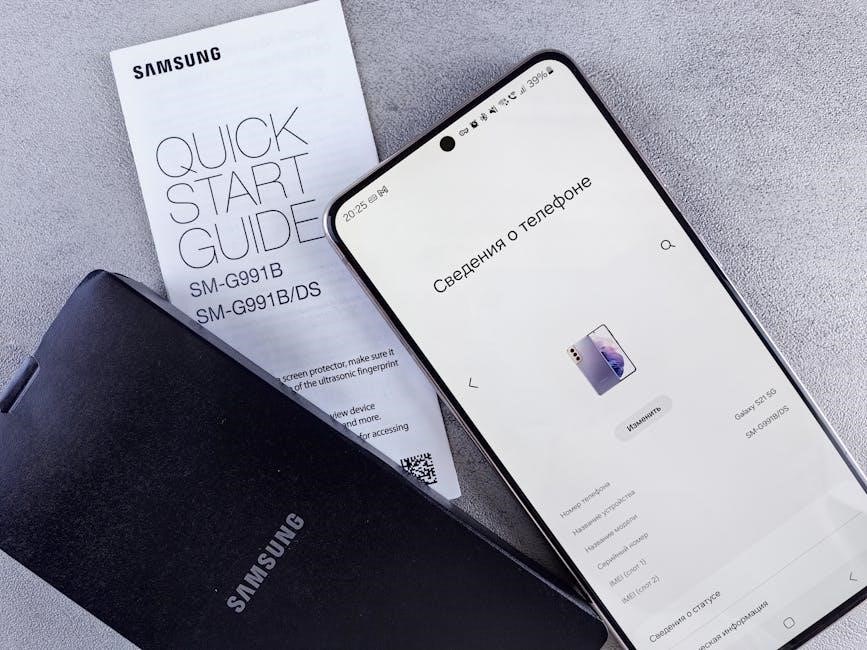The MicroKORG is a compact, versatile synthesizer designed for portability and ease of use, ideal for musicians of all skill levels. It combines powerful sound creation capabilities with intuitive controls, making it perfect for both studio and live performances. This manual will guide you through understanding and maximizing its features to create stunning sounds and enhance your musical journey.
1.1 Overview of the MicroKORG
The MicroKORG is a compact, versatile digital synthesizer designed for musicians seeking portability and high-quality sound. With its 37-key keyboard and intuitive interface, it offers a wide range of sounds, from classic analog tones to modern electronic textures; Featuring analog modeling synthesis, built-in effects, and a 16-band vocoder, the MicroKORG is ideal for both studio production and live performances. Its lightweight design and robust feature set make it a popular choice for beginners and experienced musicians alike, ensuring limitless creativity in sound design and music creation.
1.2 Target Audience for This Manual
This manual is designed for a broad range of users, from beginners exploring synthesizers for the first time to experienced musicians seeking to deepen their understanding of the MicroKORG. It is ideal for hobbyists, professional producers, and live performers who want to unlock the full potential of this versatile instrument. Whether you’re creating sounds in a studio or performing on stage, this guide will provide the necessary insights and practical advice to help you master the MicroKORG’s features and enhance your musical creativity.
Getting Started with the MicroKORG
This section will guide you through the initial steps of setting up and familiarizing yourself with the MicroKORG, ensuring a smooth start to your musical journey.
2.1 Unboxing and Initial Setup
Carefully unbox the MicroKORG, ensuring all components are included: the synthesizer, power adapter, and manual. Place it on a flat, stable surface. Connect the power adapter, ensuring it fits securely. Turn it on and verify the display lights up. Familiarize yourself with the controls and buttons. No additional setup is needed for basic operation, but you may want to connect it to a MIDI interface or audio equipment for expanded functionality. This initial setup prepares you for exploring the MicroKORG’s features.
2.2 Connecting the MicroKORG to Your Setup
To integrate the MicroKORG into your music setup, connect it using the provided audio output jacks (L/MONO and R) to a mixer, amplifier, or recording interface. For MIDI control, use the MIDI IN and OUT ports to sync with sequencers or other MIDI-compatible devices. Additionally, you can connect headphones directly to the headphone jack for quiet practice. Ensure the power supply is stable and avoid overloading the outputs. Optional connections include a damper pedal or external controllers for enhanced performance. Proper connections ensure optimal performance and integration into your workflow.

Understanding the MicroKORG Layout
The MicroKORG features an intuitive and compact design, with controls logically grouped by function for easy navigation. The front panel includes oscillators, filters, and effects sections, while the rear houses essential connections. This layout ensures efficient sound creation and performance, catering to both beginners and experienced users. Its streamlined interface allows quick access to key parameters, making it ideal for live and studio use. This section provides an overview of the synthesizer’s design and control organization.
3.1 Front Panel Controls and Functions
The MicroKORG’s front panel is divided into logical sections for sound design and performance. The Oscillator Section includes knobs for waveforms, octaves, and detuning. The Filter Section features cutoff, resonance, and type controls. The LFO Section allows adjustment of waveforms, rate, and intensity. Additional controls include the Envelope Generator for shaping sounds and the Effects Section for adding modulation, delay, and reverb. The Data Wheel and Value Knob enable quick navigation and precise parameter adjustments. The Patch Select buttons provide easy access to sounds. This intuitive layout streamlines sound creation and live performance.
3.2 Rear Panel Connections and Interfaces
The rear panel of the MicroKORG houses essential connections for integrating the synthesizer into your setup. It includes a MIDI In/Out for connecting external devices, Audio Outputs (L/MONO, R) for sending sound to mixers or amplifiers, and a Headphone Jack for private monitoring. The DC Input provides power via the included adapter. Additionally, the USB Port allows for easy connection to computers, enabling MIDI communication and software updates. These connections ensure the MicroKORG can seamlessly integrate with both studio and live performance environments, offering flexibility and versatility for musicians.

Programming Sounds on the MicroKORG
Programming sounds on the MicroKORG involves shaping tones using oscillators, filters, LFOs, and effects to create unique and dynamic sounds tailored to your musical needs.
4.1 Basic Sound Design Concepts
Sound design on the MicroKORG begins with understanding fundamental concepts like oscillators, waveforms, and filters. Oscillators generate basic tones, while waveforms determine their shape and character. Filters refine these tones by removing or emphasizing specific frequencies. LFOs add movement by modulating parameters over time. Effects further enhance and shape the overall sound. By combining these elements, you can create a wide range of sounds from simple basslines to complex textures. Experimentation is key to unlocking the MicroKORG’s sonic potential.
4.2 Using the Oscillator Section
The oscillator section is the heart of the MicroKORG’s sound generation. It offers four selectable waveforms—sine, square, sawtooth, and triangle—as well as unique Cross and X-Mod options for added complexity. By selecting a waveform, you define the basic tone’s character. Adjust the OCTAVE and PITCH knobs to set the oscillator’s frequency. For deeper sounds, use the Fine Tune parameter to make subtle pitch adjustments. Layering oscillators or using X-Mod can create rich, dynamic textures. Experiment with these settings to craft unique tones tailored to your musical style.
4.3 Adjusting Filters and Amplifiers
The filter and amplifier sections are crucial for shaping your sound. The filter section features a multi-mode design, offering low-pass, high-pass, and band-pass options. Adjust the CUTOFF knob to determine the frequency range and RESONANCE to add intensity. The amplifier section controls the overall volume and dynamics. Use the VOLUME knob to set the base level and the EG (Envelope Generator) to create dynamic changes. Together, these sections allow you to sculpt your sound from deep basses to bright leads, ensuring your tones stand out in any mix.
4.4 Utilizing LFO and Effects
The LFO (Low Frequency Oscillator) adds movement and depth to your sounds by modulating parameters like pitch, volume, or filter cutoff. Choose from waveforms such as sine, square, or random to create dynamic variations. The effects section offers reverb, delay, and distortion, enhancing your sound’s character. Assign the LFO to control these effects for unique textures. Experiment with syncing the LFO to tempo for rhythmic effects or using it to create subtle vibrato. Balancing LFO and effects can transform basic patches into rich, engaging sounds tailored to your musical style.

Working with Patches and Programs
Patches and programs are the heart of the MicroKORG, allowing you to create, edit, and organize sounds. Patches refer to individual sounds, while programs combine multiple patches into a single setup. This section will guide you through selecting, editing, and saving your own custom patches and programs, enabling you to tailor sounds to your musical needs and enhance your creative workflow.
5.1 Understanding Patches and Programs
A patch on the MicroKORG represents a single sound configuration, including oscillator settings, filters, and effects. Programs, however, are collections of patches that can be organized for quick access during performances. Understanding the distinction between patches and programs is essential for effective sound design and live use, as it allows you to manage and recall your sounds efficiently. This section will delve into the structure and functionality of patches and programs, providing a foundation for creating and organizing your own custom sounds on the MicroKORG;
5.2 Selecting and Editing Preset Patches
Selecting and editing preset patches on the MicroKORG allows you to customize sounds to suit your creative needs. To select a patch, use the category buttons to narrow your options, then scroll through using the data wheel. Once a patch is selected, you can edit its parameters by adjusting the front panel controls, such as the oscillator, filter, and envelope settings. Experiment with real-time edits or switch to edit mode for precise adjustments. This process enables you to transform factory presets into unique, personalized sounds tailored to your music. Always save your edits as new patches to preserve the original presets.
5.3 Saving Your Custom Patches
Saving your custom patches on the MicroKORG ensures your unique sounds are preserved for future use. To save a patch, press the WRITE button, then use the data wheel to select an empty user program location. Enter a name using the character buttons and confirm with WRITE again. Your patch will be stored in the user bank, allowing you to recall it instantly. Regularly saving your work prevents data loss and keeps your sounds organized. This feature is essential for maintaining your creative output and ensuring your custom patches are always accessible.

Effects Processing on the MicroKORG
The MicroKORG offers a variety of built-in effects, including delay, reverb, chorus, and distortion, to enhance and shape your sounds. These effects add depth, texture, and polish to your creations, making them more dynamic and professional-sounding. With intuitive controls, you can easily tailor the effects to suit your music style, whether you’re producing in the studio or performing live. Exploring these effects will help you unlock the full potential of your MicroKORG and achieve the sound you envision.
6.1 Overview of Built-In Effects
The MicroKORG is equipped with a range of built-in effects, including delay, reverb, chorus, distortion, and flanger, to name a few. These effects allow you to enhance and customize your sounds, adding depth, space, and texture. Each effect type offers multiple variations, providing a wide range of tonal possibilities. Whether you’re creating lush pads, dynamic leads, or rhythmic patterns, the effects section empowers you to shape your sounds with precision. This overview provides a foundation for understanding how to utilize these effects to elevate your music production and live performances.
6.2 Adjusting Effect Parameters
Adjusting effect parameters on the MicroKORG allows you to customize the sound to your liking. Each effect type has dedicated knobs for tweaking key settings, such as level, time, feedback, and depth. For delay, you can adjust the delay time and feedback to create subtle echoes or lush reverberations. For reverb, parameters like room size and damping shape the spatial character of your sound. Experiment with these controls to find the perfect balance for your music. Real-time tweaking enables dynamic sound manipulation during performance or recording.
6.3 Using Effects in Live Performance
Using effects in live performance can enhance your sound and create dynamic moments. The MicroKORG’s real-time knobs allow you to tweak effect parameters on the fly, adding depth and interest to your music. Assigning effects to specific key ranges or controls enables seamless transitions between sounds during a performance. Experiment with delay, reverb, and modulation effects to create unique textures. Organize your patches with effects pre-configured for different songs or sections. This ensures a polished and engaging live sound, making your performances stand out.

Live Performance Features
The MicroKORG is designed to excel in live performances with its compact, portable design and real-time controls. Its arpeggiator and MIDI capabilities enhance versatility for dynamic stage use, ensuring a polished and engaging experience.
7.1 Using the MicroKORG in a Live Setup
The MicroKORG is a powerful tool for live performances, offering portability and durability. Its compact size and lightweight design make it easy to transport and integrate into any stage setup. With MIDI capabilities, it can be synced with drum machines, sequencers, or other synthesizers, creating a cohesive live rig. The real-time controls, including the joystick and knobs, allow for dynamic sound manipulation during performances. Additionally, the arpeggiator adds rhythmic interest, making it a versatile instrument for both solo artists and bands. Its battery or DC power options ensure reliability in any live environment.
7.2 Assigning Sounds to Keys and Controls
Assigning sounds to keys and controls on the MicroKORG allows for seamless integration into your live performance. Use MIDI channels to assign specific sounds to different key ranges, enabling layered or split sounds. The keyboard can be divided into zones, each triggering unique patches or external devices. Additionally, the control surface, including knobs and the joystick, can be mapped to parameters like pitch, filter cutoff, or effects, giving you real-time manipulation of your sound. This flexibility ensures dynamic and expressive performances, making the MicroKORG a versatile tool for live musicians.
7.3 Real-Time Performance Tips
Mastering real-time performance on the MicroKORG enhances your live shows. Use the joystick to manipulate pitch and timbre dynamically, adding expressiveness to your sound. Assign knobs to key parameters like filter cutoff or resonance for on-the-fly adjustments. Experiment with the arpeggiator and effects in real-time to create captivating textures. Organize your sounds into banks for quick access during performances. Use MIDI control to trigger patches or layer sounds seamlessly. Practice mapping controls to your performance style to ensure smooth, intuitive operation during gigs. This will help you deliver engaging and dynamic performances.

Editing and Saving Patches
Editing and saving patches on the MicroKORG allows you to refine and organize your sounds for easy access during performances. This process ensures your customizations are preserved.
8.1 Step-by-Step Guide to Editing Patches
To edit a patch, start by selecting it using the program select knob. Adjust parameters like oscillator waveforms, filter cutoff, and resonance. Use the data wheel for precise changes. Modify LFO settings to create dynamic effects. Experiment with amp envelope settings for shaping the sound’s contour. Save your custom patch by holding the ‘write’ button and choosing an empty slot. This process allows you to create unique sounds tailored to your musical style and preferences, ensuring your performances stand out. Always preview changes before saving to ensure desired results.
8.2 Best Practices for Saving Custom Patches
When saving custom patches, organize them logically by name or category for easy access. Use descriptive names to identify sounds quickly. Regularly back up your patches to prevent data loss. Avoid overwriting factory presets unless necessary, as they cannot be restored. Use the ‘write’ button carefully to ensure you’re saving to the correct location. Periodically review and clean up your patch library to maintain efficiency. By following these practices, you’ll maintain a well-organized and functional collection of custom sounds tailored to your needs. This ensures your creative workflow remains smooth and uninterrupted.

Advanced Features of the MicroKORG
The MicroKORG offers advanced features like MIDI control, arpeggiator functions, and synchronization with external devices, enabling deeper sound customization and seamless integration into complex musical setups.
9.1 Using MIDI with the MicroKORG
MIDI integration allows the MicroKORG to communicate with other devices, enabling control of sounds and parameters. Connect via MIDI IN and OUT ports to sync with sequencers, drum machines, or keyboards. Assign MIDI channels to transmit and receive data, ensuring compatibility with external gear. Use MIDI to trigger patches, adjust real-time controls, or record performances. This feature enhances live shows and studio productions by expanding the MicroKORG’s capabilities within a connected setup. Proper MIDI configuration ensures smooth operation and creative freedom.
9.2 Understanding and Using the Arpeggiator
The MicroKORG’s arpeggiator transforms chords into dynamic, rhythmic sequences. Engage it with the ARP ON/OFF button and customize patterns using mode, range, and tempo settings. Adjusting these parameters allows you to create diverse musical effects, from simple melodies to complex grooves. For instance, using the Random mode can add unpredictability to your tracks. Experimenting with different arpeggio patterns can elevate your sound design and performance. This feature is perfect for adding depth and interest to your music, making it a versatile tool for both studio and live settings.
9.3 Syncing with External Devices
The MicroKORG can seamlessly integrate with external devices using MIDI, allowing synchronization of tempo and control. Connect the MIDI OUT to a sequencer or drum machine to sync patterns. Use the MIDI IN to receive clock signals from external sources. The Sync button ensures precise timing alignment. You can also sync the arpeggiator and LFO to external devices for a unified performance. This feature is ideal for live setups or studio environments, enabling the MicroKORG to work in harmony with other gear for a cohesive musical experience.

Maintenance and Troubleshooting
Regularly clean the exterior with a soft cloth and avoid exposure to moisture. Dust internal components annually to ensure optimal performance. Check all connections for stability. If issues arise, consult the troubleshooting guide or update firmware as needed. Always follow proper power-down procedures to prevent damage. For persistent problems, contact authorized KORG service centers for professional assistance. Maintain your MicroKORG to preserve its functionality and longevity for years of creative sound shaping.
10.1 Cleaning and Maintaining the MicroKORG
To ensure your MicroKORG performs optimally, clean it regularly. Use a soft, dry cloth to wipe the exterior and remove dust. For stubborn marks, lightly dampen the cloth with water, but avoid liquids near openings. Turn off the unit before cleaning. Use compressed air to gently remove dust from knobs, sliders, and grilles. Avoid harsh chemicals or abrasive materials that could damage the finish. Check for firmware updates periodically and install them to maintain functionality. Store the MicroKORG in a dry, cool place to prevent damage and extend its lifespan. Regular maintenance ensures reliable performance and preserves your investment.
10.2 Common Issues and Solutions
If your MicroKORG isn’t turning on, check the power supply and ensure it’s properly connected. For stuck knobs or sliders, clean them gently with compressed air. If patches aren’t loading, reset the unit by holding the SHIFT and PROG buttons while powering on. MIDI issues? Verify MIDI settings and connections. For distorted sound, adjust the volume levels or check for firmware updates. If problems persist, consult the official KORG support or authorized service centers. Regular maintenance and updates can prevent many of these issues, ensuring smooth operation.
The MicroKORG is a powerful, user-friendly synthesizer offering endless creative possibilities. With this manual, you’re equipped to unlock its full potential and elevate your music production and performance.
11.1 Summary of Key Features
The MicroKORG boasts a robust feature set, including dual oscillators, a versatile filter section, and a range of modulation options. Its intuitive interface simplifies sound design, while the built-in effects processor enhances your creations. With 128 preset patches and 128 user patches, you have ample space for customization. MIDI compatibility ensures seamless integration with external gear, and the arpeggiator adds dynamic rhythmic possibilities. These features make the MicroKORG an essential tool for both beginners and experienced musicians seeking high-quality, portable synthesis.
11;2 Final Tips for Getting the Most Out of Your MicroKORG
To maximize your experience with the MicroKORG, experiment with layering sounds and explore its modulation capabilities. Regularly update your firmware to access the latest features. Practice saving and organizing your custom patches for easy access during performances. Don’t hesitate to use the arpeggiator and effects to add depth to your music. Finally, maintain your device by cleaning it regularly and storing it in a protective case. By mastering these techniques, you’ll unlock the full potential of your MicroKORG and elevate your sound design and live performances.

Additional Resources
Explore official KORG documentation, online forums, and tutorials for in-depth guides, troubleshooting, and inspiration to enhance your MicroKORG experience.
12.1 Official KORG Documentation
The official KORG documentation is your primary resource for mastering the MicroKORG. Available on the KORG website, it provides a comprehensive guide to all features, from basic operation to advanced sound design; The manual includes detailed instructions, technical specifications, and troubleshooting tips. Whether you’re a beginner or an experienced user, this document will help you navigate the synthesizer’s capabilities. Regularly updated, it ensures you have the latest information to optimize your MicroKORG experience. Always refer to this official guide for accurate and reliable information to make the most of your instrument.
12.2 Online Communities and Forums
Online communities and forums are invaluable resources for MicroKORG users. Platforms like KORG’s official forums, Reddit, and Facebook groups offer a space to share tips, patches, and solutions. These communities are perfect for connecting with other musicians, learning new techniques, and troubleshooting issues. Many users post their custom patches and sound design ideas, providing inspiration and expanding your creative possibilities. Active engagement in these forums can enhance your MicroKORG experience and help you stay updated on the latest trends and tricks shared by the global user base.
12.4 Recommended Tutorials and Guides
To deepen your understanding of the MicroKORG, explore official KORG tutorials and third-party guides. Websites like YouTube, Udemy, and Skillshare offer video-based lessons covering sound design, effects, and live performance techniques. Specific channels dedicated to synth tutorials often feature MicroKORG content, providing step-by-step instructions for beginners and advanced users. Additionally, user-created guides on forums and blogs share practical tips and tricks for maximizing the synthesizer’s potential. These resources complement this manual, offering hands-on learning and real-world applications to enhance your MicroKORG skills.
